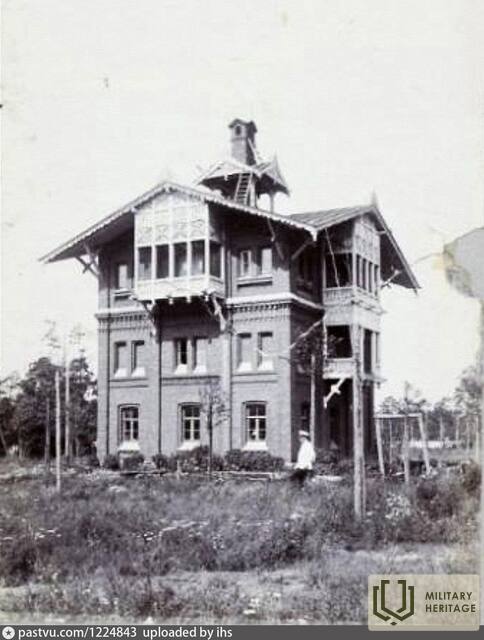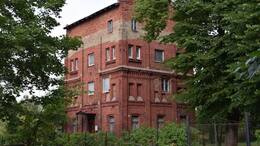Sparnuoti kareiviai
XX amžiaus pradžioje pašto balandžiai buvo plačiai naudojama bendravimo priemonė.
Su Jūrų pašto balandžių stotimi taip pat siejami keli įdomūs įvykiai. Buvo pagautas sukčiaujantis Miķelis Ozolas – jam buvo gerai sumokėta už vanagų šaudymą netoli stoties, o vyrui pavyko parodyti vištų kojas, o ne plėšrūnų nagus.
Pirmieji eksperimentai su paukščiais prasidėjo 1898 m. pavasarį. Sparnuoti pasiuntiniai buvo paimti ir paleisti iš laivo denio, esančio už 20 mylių nuo kranto. Rezultatai buvo prasti – iš 20 balandžių grįžo devyni, trys iš jų pametę ant kaklo kabančius „svarbius dokumentus“. Už nesėkmę ir karūnos turto praradimą (vienas balandis buvo įvertintas 2,68 rublio) leitenantė kapitonė Olimpa Kvastcova buvo perkelta į Sveaborgo tvirtovę. Kaip vėliau paaiškėjo, pavasaris paskatino kai kuriuos į kovinę misiją pasiųstus persikelti į miestiečių namų palėpes išlaisvinti balandinių. 1901 m. vasarą eksperimentai buvo tęsiami, paleidžiant paukščius iš laivų Gdansko uosto reido metu. Šį kartą Rusijos diplomatams teko aiškintis, nes dėl kažkokių priežasčių prūsai reiškė pasipiktinimą tokiu savotišku Rusijos karinio jūrų laivyno aktyvumu Vokietijos teritoriniuose vandenyse su taikiais Liepojos tvirtovės lėktuvais. 1904 m. vasarį Liepojos uosto reidą gaubė dūmai iš 2-osios Ramiojo vandenyno eskadrilės karo laivų. Iš stoties laivų į jūrų mūšių vietas Korėjos ir Japonijos jūrose buvo „komanduoti“ 200 balandžių. Lapkričio 5 d., kai kreiseris „Oleg“ buvo išvykstančioje armadoje už 200 mylių nuo Liepojos, sulūžo laivo sraigtas. Vadas, antro rango kapitonas Otto Richteris, netikėdamas stebuklu, vis dėlto įsakė 14 val. paleisti penkis balandžius iš denio su pranešimu apie kėzą. Lapkričio 6 d. rytą, 4 val., dviejų balandžių nešama žinia atsidūrė ant Liepojos bazės vado admirolo Irecko stalo. Liepojos stoties balandžiai taip pat dalyvavo dideliuose Rusijos Baltijos laivyno manevruose 1907 m. vasarą. Pavyzdžiui, iš minų sviedinių „Ukrainec“, „Gaidamak“ ir „Vsadņik“ už 30 mylių nuo kranto buvo paleisti 25 balandžiai, iš kurių septyni dingo. Didžiausia balandžių partija – 197 – buvo patalpinta transporto laive „Angāra“ ir paleista po penkis iš narvų, esančių už 50 mylių. 13 balandžių negrįžo. Iki 1914 m. pašto balandžiai buvo gana sėkmingai naudojami ryšiui iš Liepojos su Rusijos pakrantės artilerijos baterijomis dabartinėse Hyjuma ir Saremos teritorijose.
Susijusi laiko juosta
Susijusios temos
Susijusios vietos
Karvelių pašto jūrų stotis Karostoje
Buvusi karinio jūrų laivyno balandžių stotis Nr. 2 – iš tikrųjų veisimo stotis – yra Karostoje, Pulkveža Brieža gatvėje 6. Ji buvo pastatyta 1899–1900 m. ir buvo skirta apgyvendinti apie 450 pašto balandžių – sparnuotųjų karių. Vėlesniais metais pastatas buvo pertvarkytas į butus, todėl išliko tik raudonų plytų pastato korpusas. Kita pašto balandžių stotis, Nr. 1, kuri neišliko, buvo skirta 750 sausumos karių naudojimui ir buvo įsikūrusi Atmodas bulvaro šiauriniame gale.
Pašto balandžiai buvo paprastas, greitas ir patikimas būdas užtikrinti ryšį tarp kranto ir laivų jūroje. Nors radijo telegrafas, kaip moderni ryšio priemonė, tuo metu jau buvo plačiai naudojamas, balandžių naudojimas buvo laikomas saugesniu – priešas galėjo perimti pranešimą tik perimdamas patį pašto balandį. Pašto balandžiai judėjo vidutiniu 60 km per valandą greičiu, tačiau palankiomis vėjo sąlygomis jie galėjo judėti iki 100 km per valandą greičiu. Balandžius reikėjo specialiai paruošti ir apmokyti, todėl su jais elgtis reikėjo atsargiai ir kantrybės. Pašto balandžio ryšys veikė per paukščių gebėjimą grįžti į savo namų narvelį. Kai paukštis buvo perkeltas į kitą vietą – balandžių stotį, paleidimo ir paleidimo punktą – ir paleistas su pranešimų kapsule, mažasis pasiuntinys grįždavo į savo namų narvelį. Siekiant užtikrinti ryšį tarp dviejų balandžių stočių, kiekvienoje reikėjo laikyti tam tikrą skaičių paukščių, kurie buvo užaugę korespondento ryšio, arba pašto balandžių, stotyje. Kiekvienais metais balandžiai dalyvaudavo įvairiuose manevruose ir varžybose. Taip pat po Latvijos nepriklausomybės, nuo 1920 iki 1940 m., Liepojoje buvo įsikūrusi Latvijos armijos Kuršo divizijos pašto balandžių stotis, kuri galėjo susisiekti tiek su Ryga, tiek su Daugpiliu. Tarpukariu į Latvijos teritoriją taip pat atklydo pašto balandžiai iš Vokietijos, Lenkijos, Lietuvos, Suomijos ir Estijos. Balandžiai iš Latvijos staiga buvo aptikti ir kaimyninėse šalyse.
Pastatas per daugelį metų buvo kelis kartus perstatytas ir dabar yra gyvenamasis pastatas. Tačiau išskirtinė pastato forma, pastatyta iš raudonų plytų, būdingų seniesiems Karostos pastatams, vis dar aiškiai matoma iš išorės.







